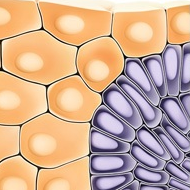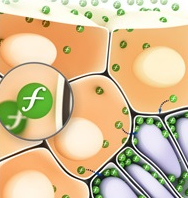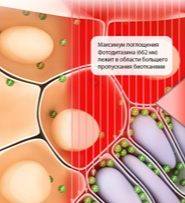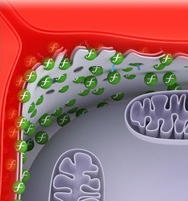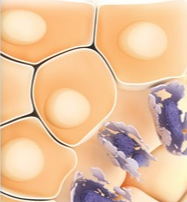Photodynamic Therapy in oncology
Photodynamic therapy in oncology is relatively young (about 20 years) direction of drug-instrumental anticancer therapy. The greatest experience gained with this method in the treatment of tumors of the head and neck, stomach, esophagus, female reproductive organs, lung and bronchus, prostate cancer, skin cancer. Considerably less experience with melanoma, primary tumors and liver metastases, intestines and pancreas.
The high selectivity of tumor lesions in photodynamic therapy in oncology allows a minimum injure surrounding healthy tissue, which leads to high functional outcome of treatment and distinguishes it from traditional therapy and absence of serious local and systemic complications.
Photodynamic therapy in oncology induces necrosis and apoptosis of tumor cells.
Photodynamic therapy with the drug "FOTODITAZIN®" in oncology led to the development of therapeutic effect in all cases. The lack of effect was noted. During the treatment according to the radical program in patients with primary and recurrent skin cancer was achieved the complete resorption in 90% of cases, the treatment of malignant tumors of the internal organs were found complete and partial resorption in 70% of cases.
Health and Social Development Minister of the Russian Federation were approved and allowed for widespread use in practical public health following medical technology and use the drug "FOTODITAZIN®":
1. PHOTODYNAMIC THERAPY OF LUNG CANCER
- Central inoperable lung cancer
- Recurrence of lung cancer after surgical and combined therapy
- Stenosing bronchus cancer
- In case of contra-indications for surgery and ineffectiveness of chemo- and radiation therapy
- Palliative purpose for improvement of quality of life of cancer patients
2. PHOTODYNAMIC THERAPY OF BASAL CELL CARCINOMA AND SKIN KERATOSIS
- Basal cell carcinoma and skin keratoses of various localizations (T1-T4, Mo)
- Patient’s refusal from conventional therapy
- Tumors, resistant to standard methods of treatment
- High risk of complications after radiation therapy and surgery in older patients and patients with somatic disorders
- Patients who cannot receive conventional therapy owing to different reasons
- Recurrences, residual tumors and tumors with the infiltration depth of more than 0.5 mm
- Infiltrating ulcerous forms of basal cell carcinoma of different localizations
- Palliative purpose for improvement of quality of life of cancer patients
 Chn
Chn
 veta-grand@mail.ru
veta-grand@mail.ru  +7 499 250 40 00
+7 499 250 40 00 


 Find us in VKontakte
Find us in VKontakte Find us in Odnoklassniki
Find us in Odnoklassniki Find us in Twitter
Find us in Twitter Find us in Telegram
Find us in Telegram Wikipedia
Wikipedia Presentation
Presentation